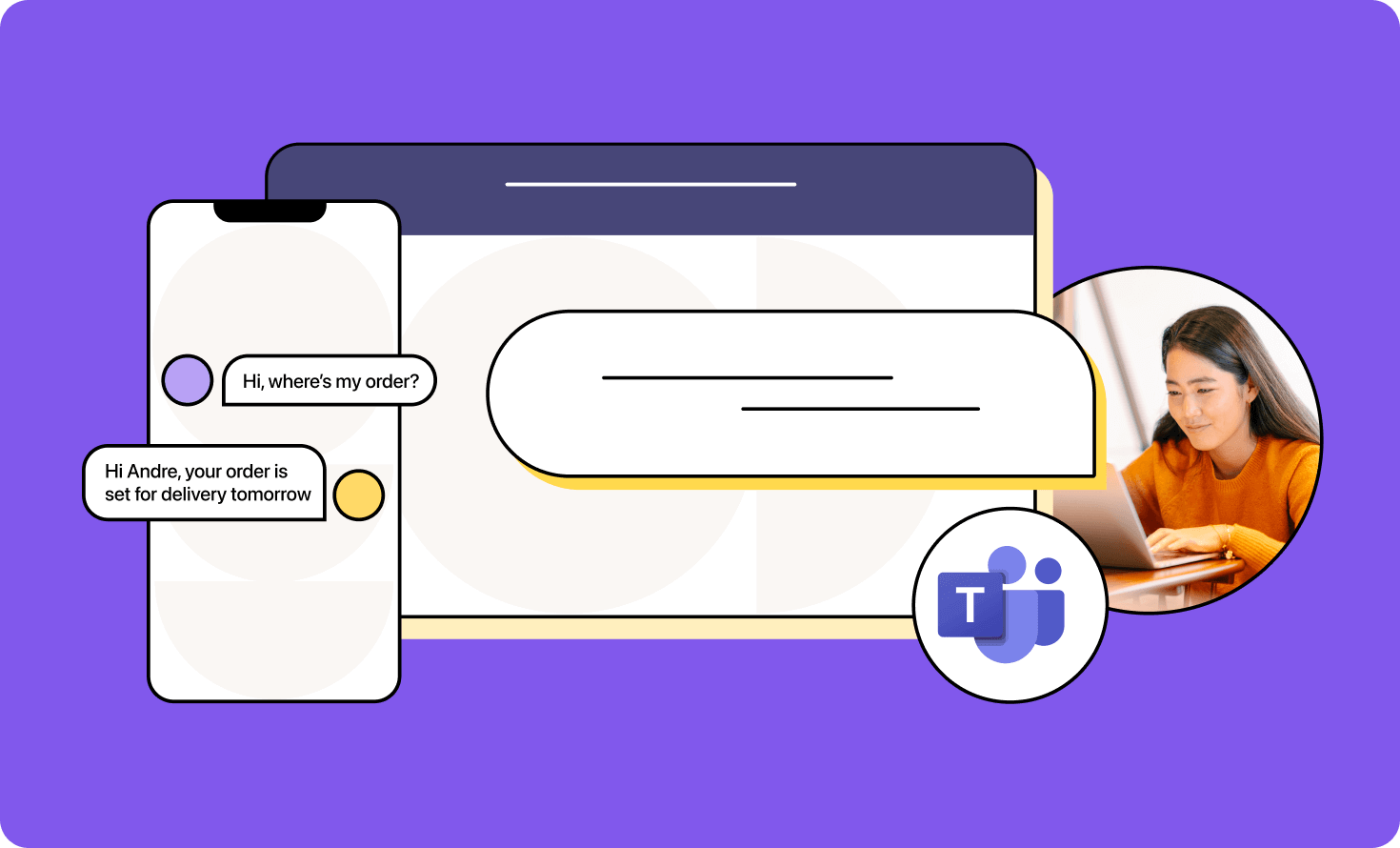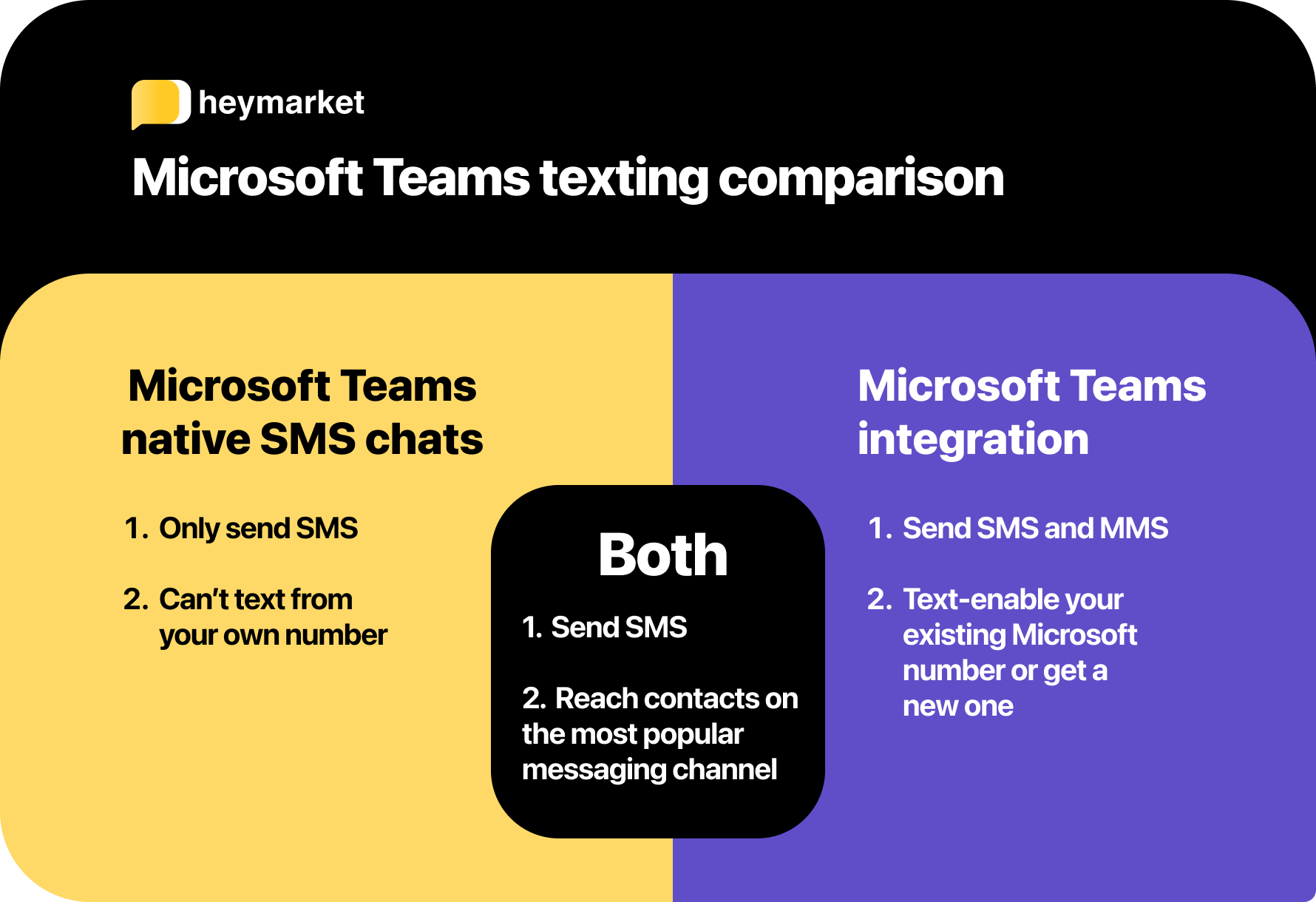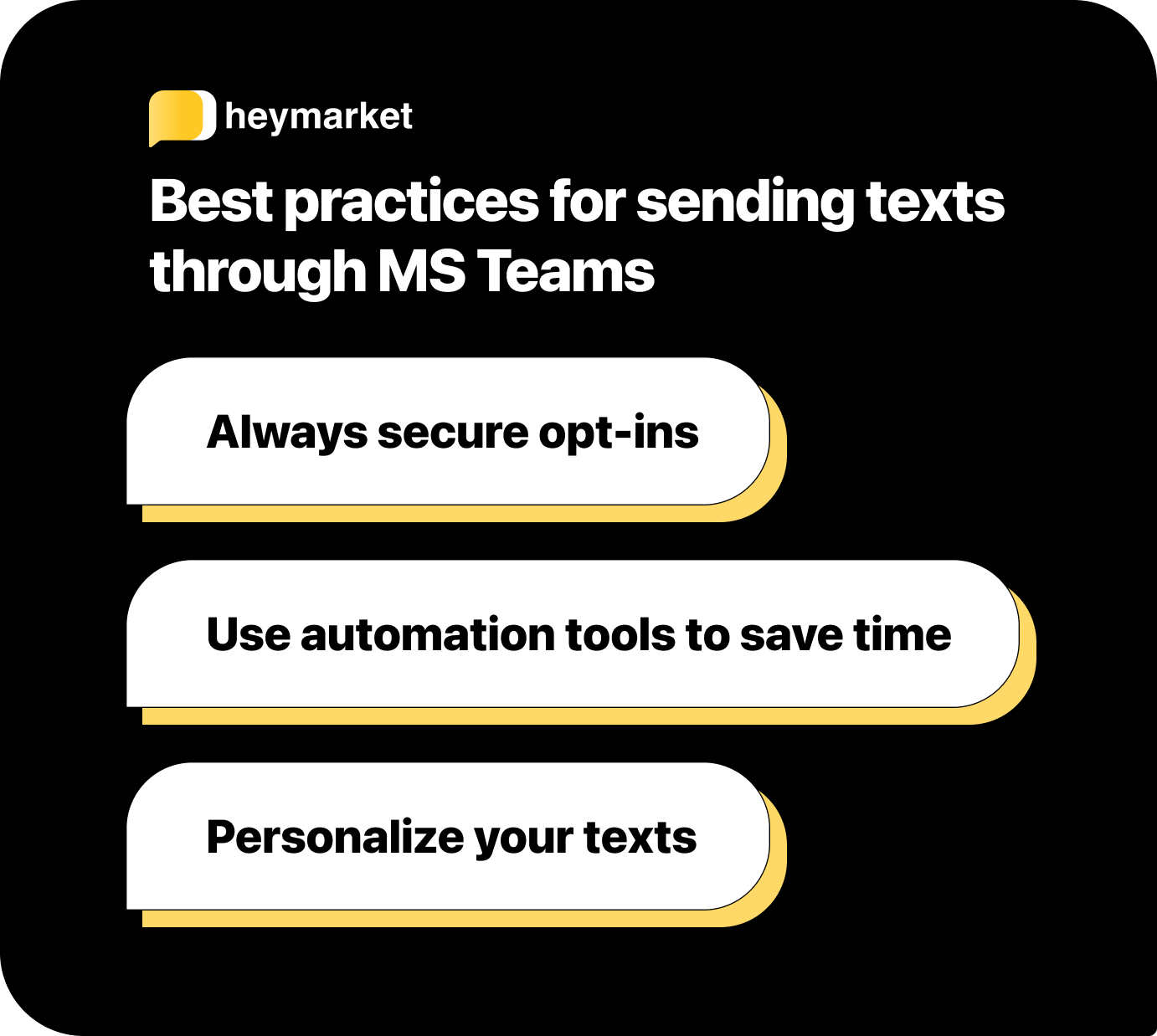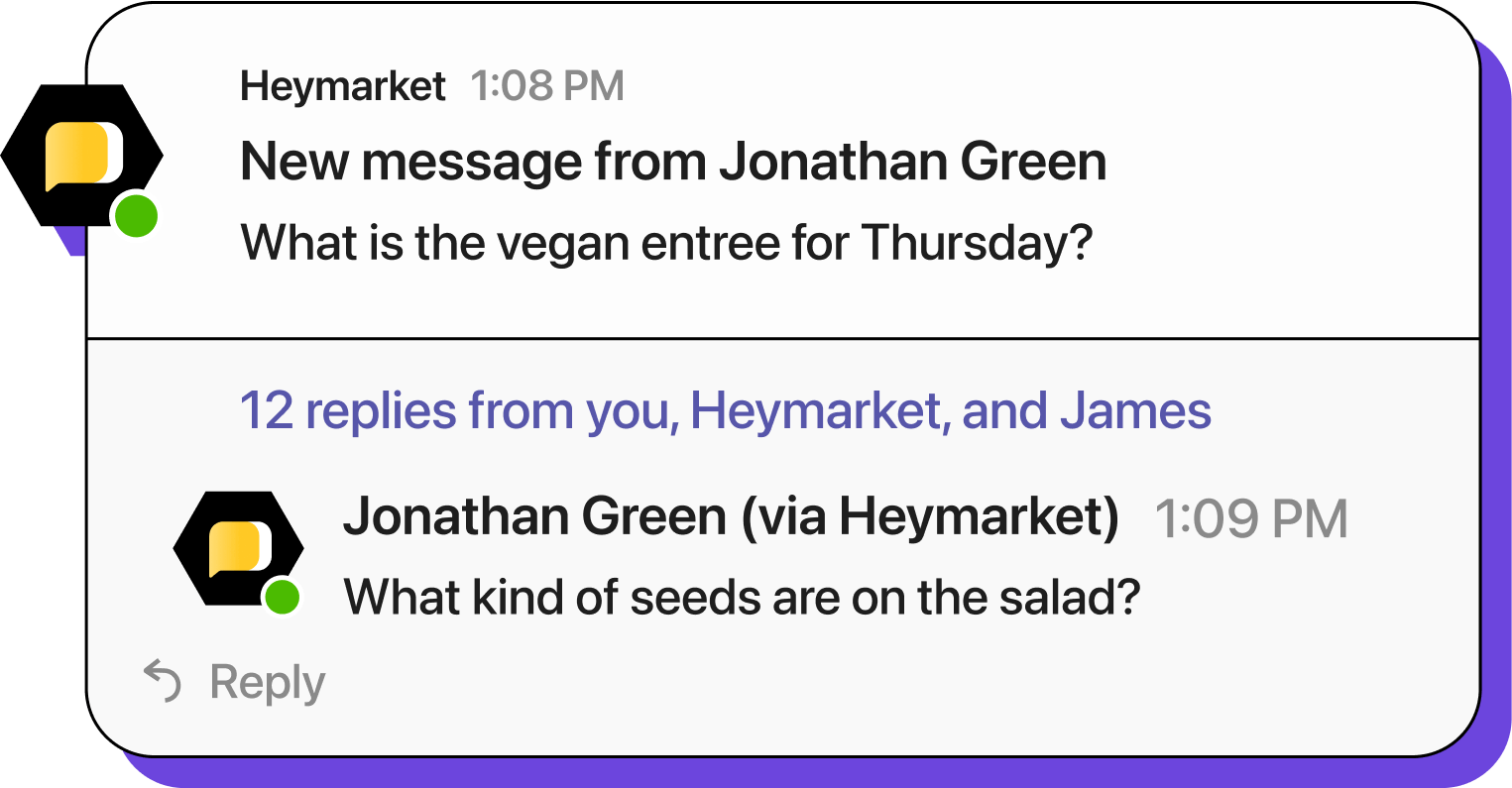How to Use Microsoft Teams SMS to Send & Receive Texts

If you use Microsoft Teams and need to talk with your colleagues, chances are you don’t need to leave Teams unless it’s an in-person conversation. That’s probably because Teams lets you chat with your teammates, collaborate and share documents, jump onto voice calls, and have face-to-face Meetings. Really, is there anything it can’t do?
Microsoft Teams was purpose-built for communicating within an internal team. But as customer demand for texting with businesses grows, so has business’ interest in messaging customers right from Teams, where they can collaborate with their own team to answer questions. But can Microsoft Teams receive and send text messages?
Microsoft Teams recently added a new Microsoft Teams SMS feature that provides limited texting support. However, it may not be enough for your needs. Keep reading to learn the different ways you can send a text message through Microsoft Teams and learn which is best for you.
What are Microsoft Teams SMS participant chats?
SMS chats are Microsoft’s solution for native Microsoft Teams messaging with customers and contacts. They allow for sending messages from Teams to external contacts, removing the limitation of only texting app contacts. These messages are routed through the app instead of being sent directly from another mobile device, which allows them to include your name so that contacts know who they’re talking to.
Each conversation begins with your message, followed by a link to join Teams that lets the recipient continue chatting in the app. Alternatively, the recipient can respond directly to the texts to connect with you.
The limitations of using Microsoft Teams messaging
Adding texting capabilities has allowed Teams to answer to the popularity of texting for business communications today, with global business messaging traffic set to reach 2.8 trillion messages by 2027. However, the feature is new and text messaging wasn’t originally a primary focus of the app, so there are some limitations that you will face if you rely on its native SMS solution for talking to contacts.
You can’t text from your own number
A primary limitation of using the native Microsoft Teams SMS feature is that you can’t use your own number to communicate with contacts. All SMS you send route through Microsoft before being delivered to their phone, causing the contact information to include an unknown short code number. These short codes are not in the standard 10-digit format, so may be interpreted as promotional texts. As a result, concern about receiving spam texts can make contacts hesitant to respond. You may also lose the opportunity to build trust through consistent brand messaging from your own dedicated number that your customers are familiar with.
You can only send SMS
The ability to send texts to leads and customers is great for reaching them effectively, but some messages perform better than others. Using MMS instead of SMS lets you include pictures, videos, and other media that help to personalize the interaction and provide more complete information to contacts. However, Microsoft Teams messaging limits messages to just SMS, so you can’t send any additional media alongside your texts.
Despite any limitations, one of Microsoft Teams’ biggest benefits is that it integrates with multiple third-party tools. These tools empower you to send messages, both via SMS and MMS, as well as on popular messaging channels like Facebook Messenger, to coworkers or customers.


Want to start sending texts from Microsoft Teams? Check out Heymarket’s Microsoft Teams SMS integration.
Learn MoreHere’s how to send a text through Microsoft Teams.
Step one: choose a third-party messaging app
Before you send your first text through Microsoft Teams, you need to choose the right third-party messaging integration from Microsoft’s AppSource. Many SMS apps require you to send texts through their SMS platform, rather than directly through Teams. To send a text through Microsoft Teams itself, find a product that allows you to send texts right from the Teams interface.
Look for a messaging integration that allows you to:
- Start new texting chats from within a Microsoft Teams channel
- Receive and reply to texts from within a Microsoft Teams channel
- Receive and reply to messages from popular apps (e.g., Facebook Messenger) from within a Microsoft Teams channel
- Use pre-made message templates from an integration-specific Tab within Microsoft Teams
Once you’ve identified a tool that offers these features, you can start setting up your Microsoft Teams SMS integration.
Step two: configure the messaging integration
Configuring a messaging integration should only take an hour at most with help from a step-by-step guide. In this phase, what you’re doing is ensuring that both platforms are set up to share data and take actions in one another.
To configure the messaging integration, you will need to:
- Download the third-party messaging app within Microsoft Teams. The Microsoft Teams AppSource marketplace offers multiple direct SMS integrations, like Heymarket and Text Bot.
- Set up the third-party messaging app (if you haven’t already done so). This process will likely include sharing your basic information (like email address and company name), as well as authenticating this information.
- Confirm the integration in both platforms. Within your business SMS platform, you should see a new screen that allows you to set up the Microsoft Teams SMS integration. You’ll follow the guided process, which asks you to begin an authentication process within Microsoft Teams SMS.
- Decide which business texting inbox will map to which Microsoft Teams channel. If you have multiple SMS inboxes for multiple teams (like Sales and Customer Service) you will have to make this decision. You’ll also need to decide on the Microsoft Teams channel these rerouted messages will go to.
- Map your business SMS inbox to your designated channel. Now that you’ve made that decision, you can proceed with the setup process. On the Microsoft Teams integration page within your business SMS platform, choose your inbox and Microsoft Teams channel.
- Test the integration. Finally, your business SMS platform will send your Microsoft Teams channel a message. If you set up the integration properly, you’ll receive a text within your designated Microsoft Teams channel.
In this step, you’ll notice that both Microsoft Teams and your third-party messaging app require a lot of authentication. This is a good thing: since you will be texting customers and business partners, you’ll want to ensure that there are security measures in place to protect their personally identifiable information (PII).
Step three: learn basic texting features
Before you send a text to a customer or business partner, you’ll want to learn how to use basic texting features, exploring how exactly they work within Microsoft Teams.
All third-party messaging apps don’t offer the exact same features. They’ll allow you to text in different ways. For a platform like Heymarket, for example:
- You have to mention the bot @Heymarket to text a phone number.
- You can start a new SMS conversation in Teams by @mentioning Heymarket, choosing Heymarket from the hint pop up, then choosing the selected action to start a conversation. The formula looks like this:
- Template: @Heymarket text [Phone] [Text Message]
- Full Example: @Heymarket text 1(415)423-3980 Hi Janet, don’t forget your meeting with Charlie from Swift Shoes Sales tomorrow at 6!

- You’ll receive replies in a single Teams channel, which you designate. Answer these texts by @mentioning Heymarket again.
- You can send a single message to a list of your customers from within Teams. Recipients will not see one other and can respond back to your team. The formula looks like this:
- Template: @Heymarket [List name] [Text message]
- Full Example: @Heymarket [Recruits] [Please submit your time sheets by EOD tomorrow!]

To learn these key features and make sure your Microsoft Teams SMS integration is working, text your own number (or one of your other business numbers) from Microsoft Teams SMS.
Step four: start sending and receiving texts
After you’ve set up the Microsoft Teams SMS integration, it’s time to start sending texts to customers and replying. Remember that, depending on the third-party messaging app you choose, you may need to @mention the messaging app before you can send your texts. Then, you’ll be able to manage customer texts from your favorite team collaboration channel.
Best practices for sending texts through MS Teams
Text messages are great customer service and marketing tools, but you need to do them right – no matter what platform you text through.
Here are some tips for sending effective texts with Microsoft Teams SMS.
Always secure opt-ins
You must have permission to text any contact that you send a message to, except when directly responding to an incoming message like a question or request for support. These cases include marketing copy and advertisements, order updates, and most other notifications. To help facilitate this, look for a texting platform with advanced administration controls, including opt-in management.
Use automation tools to save time
One of the major benefits of using a business texting platform for Microsoft Teams messaging is the expanded automations that are available. MS Teams has Power Automate, which allows for some workflow creation with certain triggers and message prompts. A Microsoft Teams integration like Heymarket allows you to create auto-replies to incoming messages, establish workflows with action and time-based automations that nurture customer relationships, add contacts to lists upon opt-in, and generate reports to help inform your process going forward.
Personalize your texts
If you want your leads and customers to interact with your texts, you need to engage them effectively. Details like the contact’s name, meeting information, customer loyalty status, and other dynamic pieces of data all help to build a better connection and make for a tailored experience that improves satisfaction scores by as much as 20%. If you don’t use a business texting solution that allows for custom fields, personalization becomes more difficult for larger SMS lists. However, it’s always worth working to personalize texts where possible.

The Bottom Line: Using Microsoft Teams Text Messaging
While Microsoft took a big step forward when they added Microsoft Teams messaging to Teams, it’s not a comprehensive solution for all business texting purposes. Fortunately, it’s integration-friendly, which allows you to build on what it can do without leaving Microsoft Teams to text.

Want to learn more about sending texts through Microsoft Teams? Explore Heymarket’s Microsoft Teams integration.
Learn More






